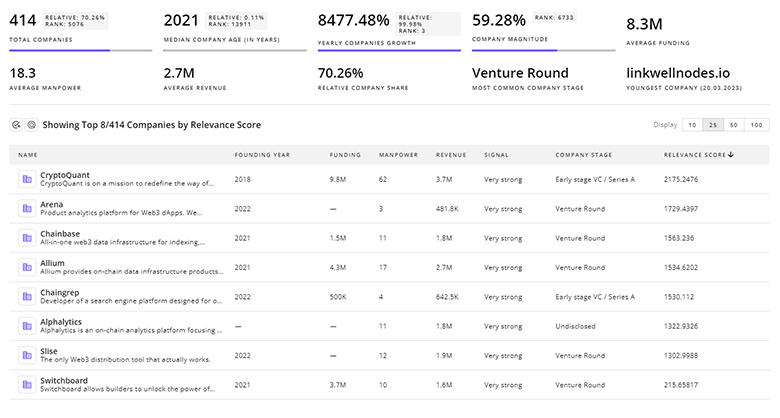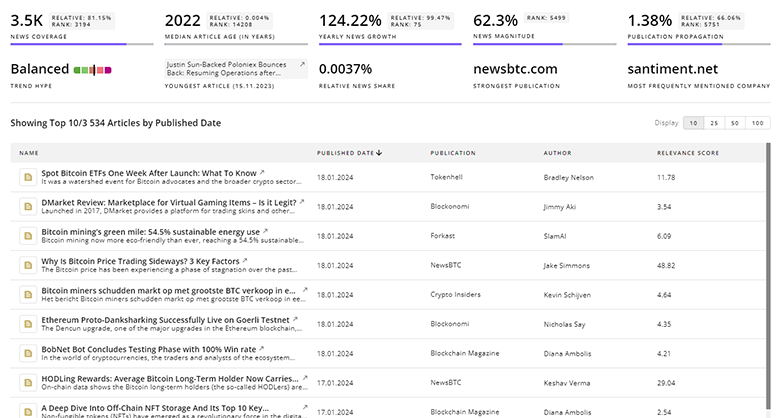
AI Risk Management Report
: Analysis on the Market, Trends, and TechnologiesThe AI risk management market is maturing quickly and is becoming a board-level business function: the available internal data records a market size of $6.7 billion in 2024 with a projected CAGR of 12.6% to roughly $13.6 billion by 2030, and patent activity rose ~70% between 2021 and 2023—signals that technology, regulation, and vendor activity are converging to scale commercial solutions and institutional adoption.
This report was last updated 38 days ago. Spot an error or missing detail? Help us fix it by getting in touch!
Topic Dominance Index of AI Risk Management
To identify the Dominance Index of AI Risk Management in the Trend and Technology ecosystem, we look at 3 different time series: the timeline of published articles, founded companies, and global search.
Key Activities and Applications
- AI model validation, continuous testing, and drift detection—automated pipelines for model validation and ongoing monitoring (including drift and performance regression) are now core to model risk programs because model complexity and deployment velocity increase audit exposure and operational loss potential.
- Explainability, bias detection, and decision audit trails—firms embed interpretability tooling to produce human-readable explanations and audit evidence required by regulators and internal governance.
- Quantitative risk scoring and financial impact mapping—translating model failures into dollar exposure (loss-estimates, earnings-at-risk) enables prioritization of mitigation spend and supports insurance and capital-allocation decisions.
- Third-party and vendor AI risk assessment—assessing the risk posture of external models, data suppliers and platform providers has moved from checklist activity to continuous monitoring as enterprises consume more prebuilt AI components.
- Generative AI safety and hallucination mitigation—targeted tooling for prompt-safety, hallucination detection, and provenance tracking for LLM-based flows (content, code, decisions) is a fast-growing practical use case.
Emergent Trends and Core Insights
- Platform consolidation vs. point tools: market signals indicate buyers prefer integrated Governance-Risk-Compliance platforms that combine compliance workflows, model validation, and security telemetry; vendors that cannot integrate across those domains risk commoditization of their modules and external market analysis finds platform demand driving vendor M&A and product bundling activity AI-model Risk Management Market.
So what: procurement cycles will favor vendors who supply unified evidence chains for auditability and cross-domain risk correlation. - Regulation driving productization: rising regulatory frameworks (EU AI Act, NIST AI RMF adoption expectations) push firms to buy automated compliance and monitoring features rather than build one-off controls AI in Risk Management Market.
So what: regulatory proofs (dashboarded audit trails, automated impact assessments) become procurement gatekeepers in regulated sectors (finance, healthcare). - AI-for-risk-management (meta-AI): vendors increasingly embed ML to detect model failure modes, bias patterns, and adversarial behavior rather than relying solely on rules; this raises both efficacy and systemic risk concentration questions.
So what: customers must evaluate not only model outputs but the vendor’s own model governance and test coverage. - Real-time, continuous monitoring and automation: continuous pipelines (real-time telemetry, alerts, auto-remediation playbooks) are replacing periodic model reviews, enabling faster detection and reduced dwell time for risky events.
So what: operational teams will need to shift staffing from manual review to exception handling and governance design. - Sector specialization: finance and healthcare lead demand for model risk and explainability while enterprise GRC buyers push for cross-domain integration; market forecasts show strong growth in model-risk management subsegments driven by these verticals AI-model Risk Management Market.
So what: go-to-market segmentation should prioritize certified compliance features for high-regulation verticals.
Technologies and Methodologies
- Machine learning and large models for risk detection and scoring—used both to power product capabilities (anomaly detection, root-cause inference) and to create the “AI-for-AI” tooling that surfaces model weaknesses.
- Explainable AI techniques (feature attribution, counterfactuals, decision-trajectory comparison)—required for auditability and to reduce regulatory friction; vendors increasingly package XAI outputs into compliance-ready artifacts.
- Data fusion and knowledge graphs—fusing internal telemetry, third-party threat feeds, regulatory text and business context enables multi-dimensional risk scoring and causal analysis.
- Probabilistic modeling and stress testing—Monte Carlo, scenario simulation and loss-distribution estimation link model behavior to financial impact metrics used in capital and insurance decisions.
- Federated learning and privacy-preserving ML—enable model validation and monitoring across data silos where legal or sovereignty constraints block centralized datasets.
- Threat modeling adapted to ML systems and adversarial testing (red teaming)—security methods now include model-targeted attack simulations and poisoning/resilience tests as part of the SDLC IriusRisk and domain vendors support threat models for AI components.
- Integration with regulatory frameworks and standards (NIST AI RMF, EU AI Act)—platforms that map controls and produce auditable evidence against these frameworks accelerate buyer adoption AI-model Risk Management Market.
Comparative market forecasts (select sources)
| Source | Representative forecast / CAGR |
|—|—|
| Internal trend data: “ai risk management” | Market size 2024 = $6.7B; CAGR 12.6%; 2030 ≈ $13.6B |
| MarketResearchFuture (AI-model Risk Management) | 2025 = $6.19B → 2034 = $23.38B; CAGR 15.91% AI-model Risk Management Market |
| Market.us (AI in Risk Management) | 2023 = $10.3B → 2033 = $39.9B; CAGR 14.5% AI in Risk Management Market |
Interpretation: forecasts vary by scope and definition (model-risk-only vs broader AI-in-risk solutions). The internal projection is more conservative than some vendor/consultant reports but all sources agree on double-digit CAGR and a multi-billion-dollar market over this decade.
AI Risk Management Funding
A total of 303 AI Risk Management companies have received funding.
Overall, AI Risk Management companies have raised $4.3B.
Companies within the AI Risk Management domain have secured capital from 1.0K funding rounds.
The chart shows the funding trendline of AI Risk Management companies over the last 5 years
AI Risk Management Companies
- 4CRisk.ai—4CRisk.ai builds AI-powered regulatory and compliance intelligence focused on unstructured regulatory text and GRC workflows; the company claims large speed-ups in regulatory research and automated impact assessments that reduce manual compliance cost while creating machine-readable regulatory vectors for continuous monitoring. The product targets medium and large financial firms coping with complex multi-jurisdictional rules and frequent regulatory change; their profile shows early-stage funding and a narrow vertical focus that aligns with the model validation and compliance activities described above.
- Artificial Intelligence Risk, Inc.—AI Risk, Inc. focuses on secure deployment and governance of LLMs in private cloud contexts and packages cybersecurity, compliance, and controls for high-risk AI applications; the company emphasizes control over third-party LLMs, bias/security scanning and enterprise-ready agent patterns. That positioning directly answers the generative-AI safety, vendor risk, and secure-deployment use cases highlighted in the market.
- ARETE—ARETE offers an AI-enhanced Risk Assessment Profiler (RAPai) that integrates a live AI risk advisor (ChatGPT integration) into classical risk workflows for portfolio-level risk decisions across projects, vendors and cyber programs. Their approach illustrates the trend of embedding conversational AI into risk tool-chains to accelerate scenario analysis and decision support for technical and executive users.
- CRAID—CRAID provides AI risk management services that combine hands-on AI-system engineering experience with business risk assessment; their services focus on evaluating technical failure modes, compliance gaps and operational implications of deploying ML and LLMs. CRAID represents the professional-services side of the market that many enterprises use to supplement tooling during adoption and certification projects.
- RiskBeam GmbH—RiskBeam targets quantitative cyber resilience and maps cyber exposures to financial impact metrics, supporting objective risk quantification and prioritization across assets; their methods (cyber metrics, financial impact modeling) align closely with the market need to translate AI and cyber incidents into dollar-based exposure for executive decision-making and insurance conversations.
Identify and analyze 1.3K innovators and key players in AI Risk Management more easily with this feature.

1.3K AI Risk Management Companies
Discover AI Risk Management Companies, their Funding, Manpower, Revenues, Stages, and much more
AI Risk Management Investors
TrendFeedr’s investors tool offers a detailed view of investment activities that align with specific trends and technologies. This tool features comprehensive data on 1.5K AI Risk Management investors, funding rounds, and investment trends, providing an overview of market dynamics.

1.5K AI Risk Management Investors
Discover AI Risk Management Investors, Funding Rounds, Invested Amounts, and Funding Growth
AI Risk Management News
Stay informed and ahead of the curve with TrendFeedr’s News feature, which provides access to 1.4K AI Risk Management articles. The tool is tailored for professionals seeking to understand the historical trajectory and current momentum of changing market trends.

1.4K AI Risk Management News Articles
Discover Latest AI Risk Management Articles, News Magnitude, Publication Propagation, Yearly Growth, and Strongest Publications
Executive Summary
AI risk management is shifting from experimental pilots to operationalized, compliance-driven programmes that combine continuous model validation, explainability, security testing, and financial impact mapping. The market metrics (multi-billion-dollar sizing, double-digit CAGRs) and patent and news activity show rapid vendor innovation concentrated on model validation, XAI, and third-party risk. Buyers in regulated verticals will prioritize integrated platforms that supply audit-grade evidence, continuous monitoring, and vendor risk controls; vendors should align product roadmaps to deliver mapped compliance artifacts, real-time telemetry, and financialized risk scoring. Organizations evaluating suppliers must treat vendor governance (the vendor’s own models, data practices, and audit capabilities) as a core procurement criterion to prevent control gaps when AI is embedded into decision workflows.
Interested in enhancing our coverage of trends and tech? We value insights from experts like you - reach out!










